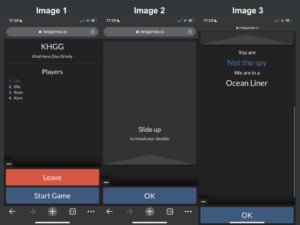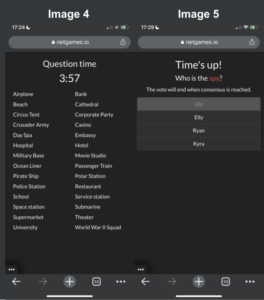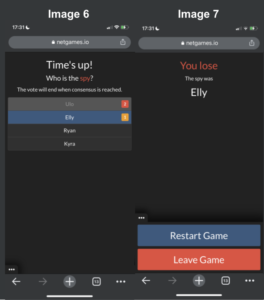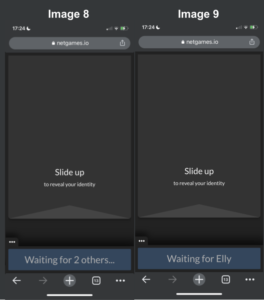Hi everyone! For my first critical play, I chose to play Spyfall with a few of my friends! I’ve heard other people talk about the game throughout the pandemic but don’t think I ever got the chance to play.
As I said, the name of the game is Spyfall and the general game was designed by Alexandr Ushan back in 2014 originally as a card game for 3-8 players with the target audience mainly being advertised as being anyone 13+ or in some cases 12+ (Source). I think the premise of the game is pretty innocent that I could be played with even younger children, maybe 10+ as there aren’t any “explicit” locations in this version of the game, but that may vary. The original game was a physical card game, however, the version that my friends and I played was hosted on the online platform netgames.io. This allows players to play the game on any device available to them that can connect to the internet (eg. I played on my phone while one of my friends played on their computer).
Getting into the notable elements of the game, I played with three other friends (a total of four players), however, it appears that you can play with more. The only player requirement that I could find on the website we played on was that there must be a minimum of three players for the game to function. I’ve seen that the maximum number of players for the online version is 8, like in the physical card game (Source).
The host of the game will navigate to the Spyfall website (https://netgames.io/games/spyfall/) and select “New Game” where they will then be given a four-letter code (like KHGG) which they then share with their friends allowing them to join the game (see image 1). Once everyone is in the group’s game, the game begins with each player being given their role: spy or not spy along with your objective. If you’re the spy, this is shared with you in red-colored text and you’re told that your goal is to try to guess the secret location of the meeting. If you’re not the spy, you’re told this in blue-colored text and are told the location of the meeting (see images 2 and 3).

From here, once everyone presses “OK” to indicate that they’re ready, the game begins. The game consists of one round which is divided into two sections: question time and voting time. During the question time, players are given a certain amount of time (shown at the top of their screens by a countdown timer) where they can freely discuss and ask each other questions to try to identify who the spy is before the time runs out (see image 4). Once the timer runs out, the players are all prompted to begin voting on who they believe the spy is by simply clicking on that person’s name (see images 5 and 6). If the players do not vote out the spy, then the spy automatically wins (see image 7), however, if the players correctly vote out the spy, the spy still has an opportunity to win if they correctly guess the meeting location.


The structure of the game creates an interesting dynamic where all of the players are suspicious of each other and can only truly trust themselves to begin with, despite there being two clear teams. As the game progresses, it becomes clear that it is a unilateral competition with multiple players playing against the single spy. This dynamic is only made more intense by the fact that the game only has one round and does not include roles similar to a seer in a game like Werewolf which allows players to have 100% certainty about another player’s role. The most interesting aspect of Spyfall to me is the objective of the spy. In the case that the players correctly vote out the spy, the creators of Spyfall instead chose to still give the spy a chance to win if they correctly guess the location of the meeting. To me this makes the game more engaging as the spy not only has the objective of keeping their identity hidden but learning the location of the meeting as well.
To me, the most similar game I can think of is Werewolf as both have that premise of one/a few against many (the werewolf/werewolves against the town and in this case the spy against those who aren’t spies). In both games, the “innocent” players are trying to identify the “dangerous” player through verbal dialogue which ultimately ends in a voting period where the “innocent” players have to vote off who they suspect is the “dangerous” player meanwhile the “dangerous” player simply has to not be voted off. Although I believe the depth and number of all the roles in Werewolf provide more depth and keep the game exciting for longer periods of time, Spyfall’s unique twist of the possibility of the spy winning whether or not they get voted out is an aspect that I really enjoy. In Werewolf, the werewolves can get unlucky and can be voted off in the first few rounds, meanwhile in Spyfall, even if the spy is voted off, they still have an opportunity to win by correctly guessing the location. Spyfall’s unique ending for the spy as well as its fast-paced gameplay of just one round makes it stand out from the other games in its genre.
Was Spyfall Fun?
My friends and I found Spyfall to be fun! As I mentioned before, all of the uncertainty creates a very engaging dynamic and the fast-paced gameplay with the relatively short questioning time only builds on this dynamic. It was also fun, but challenging to try to prove to the other players that I wasn’t the spy while not revealing enough information for them to know the location. After debriefing with my friends, we came to the conclusion that Spyfall would become less fun if we continuously played it. In this version, there are only 28 locations, and although the spy and location change from round to round, my friends and I felt like the gameplay started to feel a bit repetitive over time.
Moments of success or epic fails!
As I mentioned, there’s a very fine line that players have to navigate on where they cannot reveal too much information to the point where the spy will know the location while also sharing enough for the other players to recognize them as their teammate. In my first round, we were at a polar station and I revealed way too much information by making a comment about snow which allowed the spy to quickly narrow down every location other than the polar station. Oops!
Other than that, I felt successful as the game ran pretty smoothly from the start despite it being my first time playing the game. One feature that I really love was before we even began the game where everyone was indicating that they were ready for the game to start. After hitting “OK” to indicate you’re ready, the game displays the number of other players who we are waiting for. When we’re just waiting on one more player, the game will display the name of the person who needs to hit “OK”. In the case of my game, you can see this when we were told that we were waiting on Elly. Although it’s a small detail, I really love this feature as it helps shorten the time it takes to get into games and allows players to give their other friends reminders to ready up if they were distracted (see images 8 and 9).

Things I would change to make the game better
I think to make the game feel different over time, it could be interesting to introduce new roles. One that comes to mind is a role that is able to tamper with the grand list of locations that the spy is able to see by swapping say about four of them out with fake locations that aren’t on the “true list of locations” (the ones the innocent players see) to add another layer of confusion. To play into the narrative of the game with the premise of the players meeting at a certain location, I think it could be interesting to introduce a role/persona for the players. For example, the spy wouldn’t see anything different, but on the “innocent” players’ ends, in addition to being given the location like “Supermarket”, they’d also be given a persona like “Cashier” or “Manager”. I do struggle with how to make these broad enough so that the players won’t just prompt each other to reveal their personas at the start of the round, easily identifying the spy. Would love to hear your thoughts!



